人教版四年级英语第四单元教案
- 格式:doc
- 大小:62.50 KB
- 文档页数:12
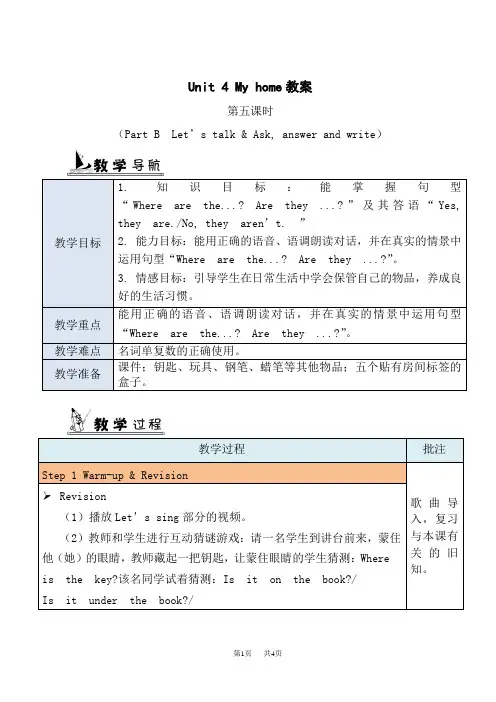
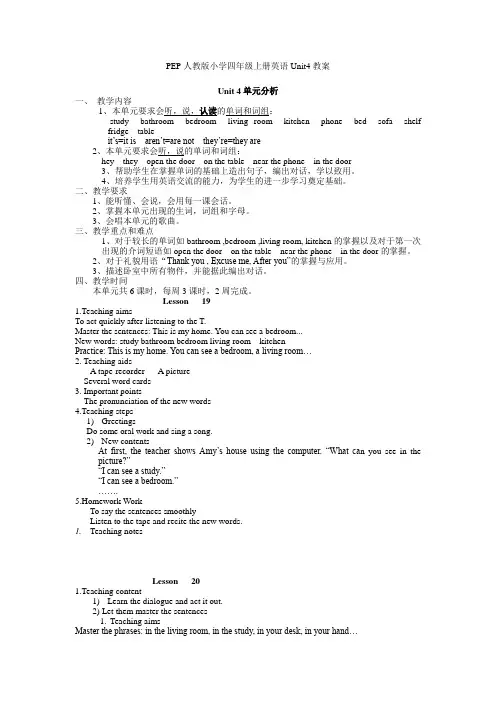
PEP人教版小学四年级上册英语Unit4教案Unit 4单元分析一、教学内容1、本单元要求会听,说,认读的单词和词组:study bathroom bedroom living room kitchen phone bed sofa shelf fridge tableit’s=it is aren’t=are not they’re=they are2、本单元要求会听,说的单词和词组:hey they open the door on the table near the phone in the door3、帮助学生在掌握单词的基础上造出句子,编出对话,学以致用。
4、培养学生用英语交流的能力,为学生的进一步学习奠定基础。
二、教学要求1、能听懂、会说,会用每一课会话。
2、掌握本单元出现的生词,词组和字母。
3、会唱本单元的歌曲。
三、教学重点和难点1、对于较长的单词如bathroom ,bedroom ,living room, kitchen的掌握以及对于第一次出现的介词短语如open the door on the table near the phone in the door的掌握。
2、对于礼貌用语“Thank you , Excuse me, After you”的掌握与应用。
3、描述卧室中所有物件,并能据此编出对话。
四、教学时间本单元共6课时,每周3课时,2周完成。
Lesson 191.Teaching aimsTo act quickly after listening to the T.Master the sentences: This is my home. Y ou can see a bedroom...New words: study bathroom bedroom living room kitchenPractice: This is my home. Y ou can see a bedroom, a living room…2. Teaching aidsA tape-recorder A pictureSeveral word cards3. Important pointsThe pronunciation of the new words4.Teaching steps1)GreetingsDo some oral work and sing a song.2)New contentsAt first, the teacher shows Amy’s house using the computer. “What ca n you see in the picture?”“I can see a study.”“I can see a bedroom.”…….5.Homework WorkTo say the sentences smoothlyListen to the tape and recite the new words.1.Teaching notesLesson 201.Teaching content1)Learn the dialogue and act it out.2) Let them master the sentences1.Teaching aimsMaster the phrases: in the living room, in the study, in your desk, in your hand…Use the dialogue smoothly.3. Important pointsThe pronunciation of the new words4.Teaching aidsA tape-recorder A pictureSeveral word cards5.Teaching steps1.GreetingSing an English song. Ask the students to introduce their homes.2.RevisionLearn the drills and practice the drills.T: What’s this? Ss: An eraser.T: yes, what does it like? S: It looks like a fish.T: Where is my eraser? Is she in the…?Ss: Y es, she is.(No, she isn’t.)Show them several pictures.T: Oh, how beautiful! Where is it?S: This is my bedroom.(This is myLiving-room. This is my bathroom.)T: Is this your ..? S: Y es, it is.(No, is n’t.)Game.-Where is my pen? -Is it in the …?- No, isn’t. - Is it in the …?-Y es, it is.Tell them the difference between “Is it…?” and “Is she…?”Listen to the tape and imitate. Practice in groups and act it out.6.HomeworkTo say the sentences smoothlyRecite the dialogue and listen to tape.2.Teaching notesLesson 211.Teaching AimsLet them master the words :home room school classroom(listening speaking reading and writing)And the sentencesWelcome to my ……home ……This is my ……room ……When they see the pictures, they can recognize and say their English names..2.Teaching Aidsa tape recorder cards pictures3.Important points4-skill words:home room school classroom4.Teaching steps1).Greeting and organizationSing an English song and do oral work.2). RevisionA:Act the dialogue of lesson 21B: Review these words:Home room school classroom3).PresentationRead the words and spell them.Ask a student come to the front to read all the words, and the others after him or her. 4).PracticeListen to the tape, imitate and practice the sentences.Read and spell the words.5. HomeworkSpell the words , then write them:Home room school classroom1.Teaching notesLesson 221.Teaching AimsLet the students master the words and phrase :phone bed shelf fridge table sofaLet the students listen and read these drill:Sit on … Make …Watch TV. Answer… Open… Set…2.Teaching Aidsa tape recorder cards pictures3.Important pointsLearn to say the words: phone shelf fridge table sofaWhen they see the subject, they can recognize and say their English names..4.Teaching steps1).Greeting and organizationSing a song and do a oral work.2). RevisionReview these words:Home room school classroom3).PresentationThe teacher shows the phone of the room and points at something one by one, and the students say it in English. In this way, learn to say the new words:phone shelf fridge table bed sofaAsk a student come to the front to read all the words, and the others read after him.4).Play a game:Passing the eight words between eight groups, and then checking which group did quickly and right.5).PracticeListen to the tape, imitate and practice the words:phone…Read and spell the words.6).Let’s doSit on the sofa. Make the bed. Watch TV. Answer the phone. Open the fridge. Set the table. 5.Homework1. Listen and read the new words and drill.2. Recite “Let’s do”.2.Teaching NotesLesson 231.Teaching content1) DrillsA: Are they on the …? A: Are they near…?B: Y es, they are. (No, they aren’t.)2)Learn the dialogue and act it out .3).Let’s chant.2. Teaching aimsLet them master the short sentences:Open the door on the table near the phoneLearn the new drills.Use the dialogue smoothly.3.important points1).The pronunciation of the new words2). A: Are they on the …? B: Y es, they are.(No, the arearen’t)4.Teaching aidsA tape-recorder A pictureSeveral word cards5.Teaching steps1).Greeting and organizationSing an English song and do oral work. Ask the students to introduce their home.2).At first, the teacher talk to the students.T: Where are the key(book…)?S: It’s on the table(in the desk, near the phone…)T: Where are the keys(books…)?S: They are on the table(in the desk, near the phone…)T: Are they on the table? S: Y es, they are.(No, they aren’t.)Then learn to say the drills. And practise the drill with the Ss. From “the T ask s, theS answers” to “the S asks, the S answers.”3) Then practise these drills smoothly.Play a game.S1:Where are the keys? S2:Are they in he …?S3: No, they aren’t. S2: Are they in the …?S3: Yes, they are.Tell them the different of “Is it…?” or“Are they…?”Listen to the recorder and imitate.Work in groups and act it out.6. HomeworkRecite the dialogue.To say the sentences smoothly3.Teaching notesLesson 241 .Teaching Aims1)Let the students master the four-skill words :Window desk door chair bed2)Let the students read these sentences:What can you see in my room? I can see…When they see the objects, they can recognize and read them and do the action about them.2 .Teaching Aidsa tape recorder.3.Difficult words and emphasis:4-skill letters and words:Window desk door chair bed4.Teaching steps1)OrganizationChant together and do a oral work.2). RevisionSpell the word: Window desk door chair bedPhrase: w_nd_w d_ _r d_sk ch___b_d3).PresentationWhen the teacher point at the subject, the students say the word and spell it. Then write these words.Read the drills smoothly:What can you see in my room?I can see…Read and choose: Listen to the T and choose A,B,C or4).Listen to the tape, imitate and read..5).GameThe teacher asks a student come to the front of the class, and tell him/her a word, then asks other students guess the word.5.HomeworkSpell and write the four-skill words :。
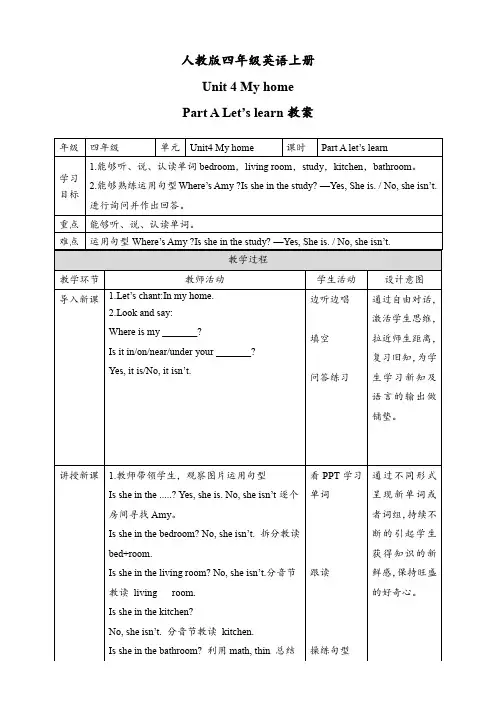
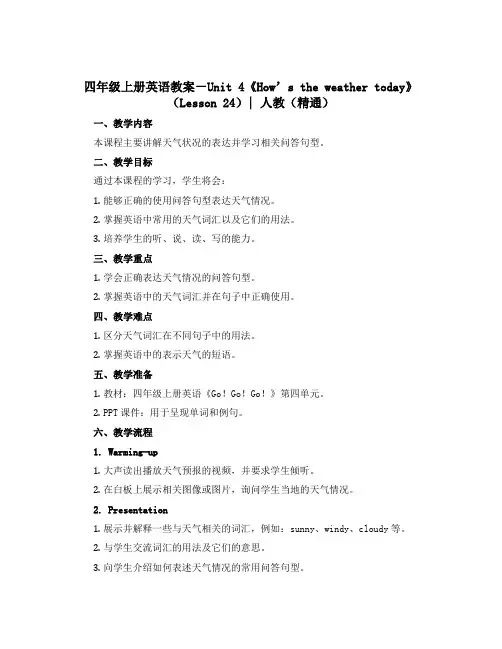
四年级上册英语教案-Unit 4《How’s the weather today》(Lesson 24)| 人教(精通)
一、教学内容
本课程主要讲解天气状况的表达并学习相关问答句型。
二、教学目标
通过本课程的学习,学生将会:
1.能够正确的使用问答句型表达天气情况。
2.掌握英语中常用的天气词汇以及它们的用法。
3.培养学生的听、说、读、写的能力。
三、教学重点
1.学会正确表达天气情况的问答句型。
2.掌握英语中的天气词汇并在句子中正确使用。
四、教学难点
1.区分天气词汇在不同句子中的用法。
2.掌握英语中的表示天气的短语。
五、教学准备
1.教材:四年级上册英语《Go!Go!Go!》第四单元。
2.PPT课件:用于呈现单词和例句。
六、教学流程
1. Warming-up
1.大声读出播放天气预报的视频,并要求学生倾听。
2.在白板上展示相关图像或图片,询问学生当地的天气情况。
2. Presentation
1.展示并解释一些与天气相关的词汇,例如:sunny、windy、cloudy等。
2.与学生交流词汇的用法及它们的意思。
3.向学生介绍如何表述天气情况的常用问答句型。
3. Practice
1.写下一些简单的问题,例如:。

PEP小学英语四年级上册第四单元《My Home》A.Let’s talk教学设计一、教学内容本课教学内容为人教版小学英语四年级上册第四单元的第一课时,也就是A 部分的Let’s talk。
二、教材分析本单元学习的主题是家里的居室及相关设施。
本单元的知识与能力目标是A、能够听、说、认读单词bedroom, living room, study, kitchen, bathroom, bed, sofa, phone, table, fridge。
B、能够听、说、认读和在情景中运用句型 Where is she? She’s in the kitchen. Is she in the living room?----No, she isn’t. Is she in the study? ----No, she isn’t. Where are they? They are...Are they in ...? Yes, they are. No, they aren’t.询问物品、人物的位置并作出相应判断。
C、能够掌握u-e的发音规则。
情感目标是在生活中能够主动询问或对别人的询问能够热情应答以及能够感受到家的温馨,从而激发学生爱家、爱家人的情感,还有能够主动收拾物品并摆放整齐,养成良好的生活习惯。
三、学情分析四年级的学生经过三年级一年的英语学习,对英语仍保持着较浓厚的兴趣,但也有个别学生已经失去了兴趣。
在三年级时已经学习过一般疑问句Is she your mother?及其肯定回答Yes, she is.和否定回答No, she isn’t, 知道一般疑问句需要用升调来读。
四、教学目标1、知识目标:听、说、认读句型Where is she? She’s in the kitchen. Isshe in the living room?----No, she isn’t. Is she in the study?----No, she isn’t.2、能力目标:在实际情景中运用句型Is she/he/it in the...?询问物品或人物的位置,并做出判断。

第四单元教学计划一、单元教学内容分析1、单元教学内容:本单元通过农场里各种动物以及农作物的学习,从而展现了农场中缤纷多彩的生活。
虽然与学生的实际生活相隔甚远,但其内容与学生的日常生活联系紧密。
要求学生能用本单元的句型与单词进行有关农场里各种动物和各种农作物的表达。
2、单元教学重点:单词:sheep, hen, cow, horse, goat, lamb及其复数形式的表达;句型:How many...do you have;四会单词及四会句子的掌握。
3、单元教学难点:字母组合or在单词中的发音。
二、单元教学目标:1、能够区分农场上常见的牲畜和蔬菜,如:goat, sheep, horse, donkey, tomatoes, potatoes.2、能够运用句型,如:What are they? Are they…?How many…?询问动物和蔬菜的名称及数量等。
3、能够根据图画,出一些农场常见的畜牲和蔬菜的名称。
三、单元教学准备:1、教师准备教学过程中所需要的图片、声音、课件,以及本单元的单词卡。
2、准备一些教师的照片或图片。
3、教师准备录音机及录音带。
四、单元教学措施:1、在教学过程中,对于学习困难的学生,可通过请学生复述老师的话或是复述同学的回答,让学生对老师和同学的发言引起注意,让学生意识到要仔细听别人的说话。
2、对于学习还不错,但是不愿或害怕发言的学生,课堂中教师主动请他们表达其意见,培养他们良好的学习英语的习惯。
3、充分运用英语名、英文歌、儿歌、绕口令、顺口溜、谜语等,给予小学生语言感染的机会。
还可开展各种活动,鼓励学生交际。
五、单元教学反思:第一课时教学目标:1、听、说、认读主要语言结构:What are these?Are these...?并能根据实际情况进行简略回答。
2、能够准确朗读对话。
教具准备:教学光盘、单词卡片。
教学重点:句型What are these?Are these...?及其简略回答。
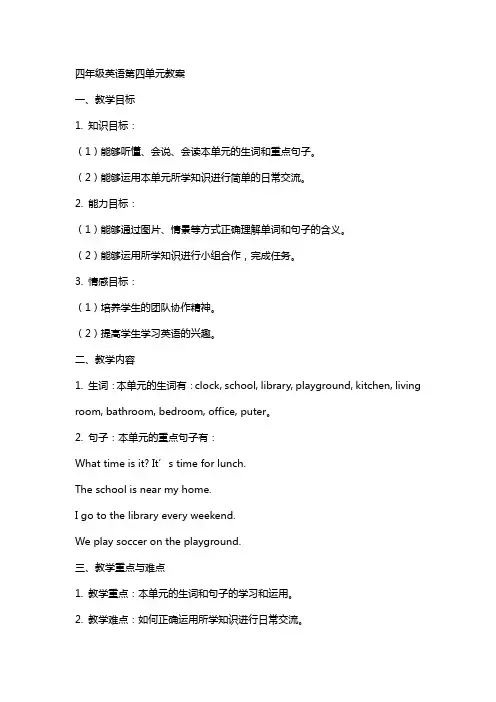
四年级英语第四单元教案一、教学目标1. 知识目标:(1)能够听懂、会说、会读本单元的生词和重点句子。
(2)能够运用本单元所学知识进行简单的日常交流。
2. 能力目标:(1)能够通过图片、情景等方式正确理解单词和句子的含义。
(2)能够运用所学知识进行小组合作,完成任务。
3. 情感目标:(1)培养学生的团队协作精神。
(2)提高学生学习英语的兴趣。
二、教学内容1. 生词:本单元的生词有:clock, school, library, playground, kitchen, living room, bathroom, bedroom, office, puter。
2. 句子:本单元的重点句子有:What time is it? It’s time for lunch.The school is near my home.I go to the library every weekend.We play soccer on the playground.三、教学重点与难点1. 教学重点:本单元的生词和句子的学习和运用。
2. 教学难点:如何正确运用所学知识进行日常交流。
四、教学方法1. 情境教学法:通过创设情境,让学生在实际情境中学习和运用英语。
2. 互动教学法:通过小组合作、角色扮演等方式,让学生积极参与课堂活动。
五、教学步骤1. 热身(5分钟):利用音乐、歌曲或游戏等方式,引导学生进入学习状态。
2. 生词教学(10分钟):利用图片、实物等方式,教授本单元的生词,让学生听懂、会说、会读。
3. 句子教学(10分钟):通过情景模拟、角色扮演等方式,让学生理解并学会运用本单元的重点句子。
4. 小组活动(10分钟):学生分组,运用所学知识完成任务,如:制作时间表、描述学校设施等。
六、教学评估1. 课堂观察:观察学生在课堂上的参与程度、发音准确性以及词汇运用情况。
2. 小组活动评价:评估学生在小组合作中的表现,包括团队合作、交流互动等。

第四单元:What's this in English?主题:本单元主要围绕学生学习英语中的基本物品名称展开,通过图片、视瓶等多种形式帮助学生掌握所学英语知识。
一、教学目标通过本单元的学习,学生能够达到以下目标:1. 掌握并能正确使用新学的英语单词:bag, ruler, pen, book, pencil, eraser, sharpener 和 t-shirt。
2. 能够听懂并能够正确回答与本单元学习内容相关的问题,如:"What's this in English?"3. 能够用英语简单介绍自己和他人所拥有的物品。
4. 能够运用所学的英语单词进行对话练习,并能够模仿相关情景对话。
二、教学内容本单元主要内容包括以下几个方面:1. 学习英语单词:bag, ruler, pen, book, pencil, eraser, sharpener 和 t-shirt。
2. 学习相关表达:What's this in English? This is a ...3. 学习与所学单词相关的日常用语表达,如:"This is my bag."、"That's my pen." 等。
4. 学习挠头与物品的连线,通过图片或实物进行相关联想。
三、教学重点1. 掌握并能够正确使用本单元所学的英语单词。
2. 能够根据实际情景正确运用所学英语进行交流。
3. 了解并能够正确回答与所学内容相关的问题。
四、教学难点1. 对于一些学生而言,英语单词的发音和记忆所带来的困难是较大的挑战。
2. 要求学生不仅能够记忆所学单词的中文意思,还要求能够正确使用这些单词进行交流。
五、教学方法1. 通过图片、视瓶和教具等形式进行课前导入,引起学生学习兴趣。
2. 老师以英语为主导语言,倡导全英文环境,使学生在情景中自然而然地学习和运用英语。
3. 通过游戏、竞赛等活动方式,激发学生的学习热情和积极性。
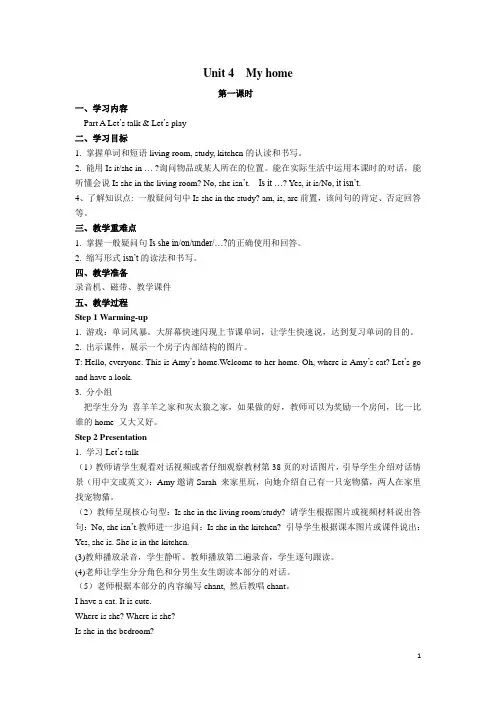
Unit 4 My home第一课时一、学习内容Part A Let’s talk & Let’s play二、学习目标1. 掌握单词和短语living room, study, kitchen的认读和书写。
2. 能用Is it/she in … ?询问物品或某人所在的位置。
能在实际生活中运用本课时的对话,能听懂会说Is she in the living room? No, she isn’t. Is it …? Yes, it is/No, it isn’t.4、了解知识点: 一般疑问句中Is she in the study? am, is, are前置,该问句的肯定、否定回答等。
三、教学重难点1. 掌握一般疑问句Is she in/on/under/…?的正确使用和回答。
2. 缩写形式isn’t的读法和书写。
四、教学准备录音机、磁带、教学课件五、教学过程Step 1 Warming-up1. 游戏:单词风暴。
大屏幕快速闪现上节课单词,让学生快速说,达到复习单词的目的。
2. 出示课件,展示一个房子内部结构的图片。
T: Hello, everyone. This is Amy’s home.Welcome to her home. Oh, where is Amy’s cat? Let’s go and have a look.3. 分小组把学生分为喜羊羊之家和灰太狼之家,如果做的好,教师可以为奖励一个房间,比一比谁的home 又大又好。
Step 2 Presentation1. 学习Let’s talk(1)教师请学生观看对话视频或者仔细观察教材第38页的对话图片,引导学生介绍对话情景(用中文或英文):Amy邀请Sarah 来家里玩,向她介绍自己有一只宠物猫,两人在家里找宠物猫。
(2)教师呈现核心句型:Is she in the living room/study? 请学生根据图片或视频材料说出答句:No, she isn’t.教师进一步追问:Is she in the kitchen? 引导学生根据课本图片或课件说出:Yes, she is. She is in the kitchen.(3)教师播放录音,学生静听。
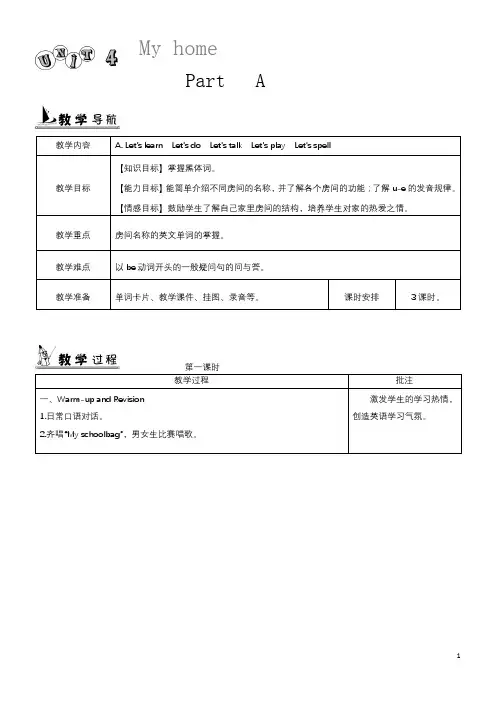
教学内容 A. Let’s learn Let’s do Let’s talk Let’s play Let’s spell教学目标【知识目标】掌握黑体词。
【能力目标】能简单介绍不同房间的名称,并了解各个房间的功能;了解u-e的发音规律。
【情感目标】鼓励学生了解自己家里房间的结构,培养学生对家的热爱之情。
教学重点房间名称的英文单词的掌握。
教学难点以be动词开头的一般疑问句的问与答。
教学准备单词卡片、教学课件、挂图、录音等。
课时安排3课时。
第一课时教学过程批注一、Warm-up and Revision1.日常口语对话。
2.齐唱“My schoolbag”,男女生比赛唱歌。
激发学生的学习热情,创造英语学习气氛。
Part A My home二、Presentation and PracticeLet’s spell1.老师拿出一支铅笔,边做“写字”的动作边说:“We use the pencilto write.”然后再拿出自己的书本,边做“读书”的动作边说:“Weuse the book to read.”帮助学生明白“use”的意思。
2.老师用课件展示出几个呆萌的动物图,学生会惊叹它们的可爱。
老师说:“Yes. They are cute.”3.老师请一位学生上讲台,假装走路不小心撞到了该学生,然后老师很礼貌地对这位学生说:“Excuse me.”引出单词“excuse”。
4.板书更多u-e单词,让学生找规律。
然后老师解释u e发音,带领学生拼读。
老师请发音标准的学生带领全班朗读。
5.老师出示含“u”的单词,带领学生拼读。
让学生判断“u”的发音和“u-e”发音是否相同。
6.做游戏。
左手代表/ ʌ/,右手代表/ju:/,老师读单词,学生根据读音来举左手或右手。
7.让学生找出“Listen, circle and say.”部分的单词,找得越多越好。
播放录音,师生共同圈单词。
8.老师挂图展示“Listen, circle and write.”部分,先让学生看图猜测所表达的意思,并圈出字母或字母组合。
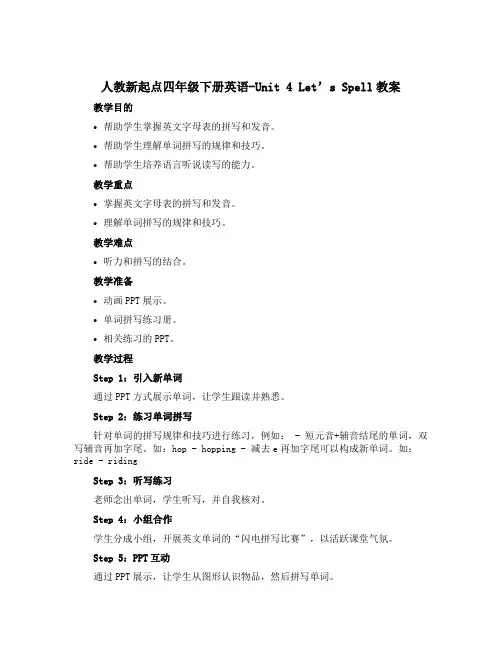
人教新起点四年级下册英语-Unit 4 Let’s Spell教案
教学目的
•帮助学生掌握英文字母表的拼写和发音。
•帮助学生理解单词拼写的规律和技巧。
•帮助学生培养语言听说读写的能力。
教学重点
•掌握英文字母表的拼写和发音。
•理解单词拼写的规律和技巧。
教学难点
•听力和拼写的结合。
教学准备
•动画PPT展示。
•单词拼写练习册。
•相关练习的PPT。
教学过程
Step 1:引入新单词
通过PPT方式展示单词,让学生跟读并熟悉。
Step 2:练习单词拼写
针对单词的拼写规律和技巧进行练习,例如: - 短元音+辅音结尾的单词,双写辅音再加字尾。
如:hop - hopping - 减去e再加字尾可以构成新单词。
如:ride - riding
Step 3:听写练习
老师念出单词,学生听写,并自我核对。
Step 4:小组合作
学生分成小组,开展英文单词的“闪电拼写比赛”,以活跃课堂气氛。
Step 5:PPT互动
通过PPT展示,让学生从图形认识物品,然后拼写单词。
Step 6:单词书写
通过练习册的方式,让学生自主练习单词的书写。
课堂总结
本堂课主要让学生学会掌握英文字母表的拼写和发音,理解单词拼写的规律和技巧。
学生通过听说读写全方位的练习,培养起了语言能力。
同时互动模式的教学让学生更积极、自信地参与其中。
人教版(PEP)英语四年级上册《Unit 4 My home》(第一课时)教案一. 教材分析《PEP》英语四年级上册Unit 4主要让学生学会描述家庭成员和他们所居住的房子。
本课时为第一课时,主要教学内容为课题“My home”和相关的词汇如:house, room, kitchen, bathroom, living room等。
通过本课时学习,学生能够听懂、会说、会读课题以及相关词汇,并能够运用所学语言进行简单交流。
二. 学情分析四年级的学生已经掌握了基本的英语发音规则和一些日常用语,对学习英语有较高的兴趣。
但部分学生可能会对一些新词汇和句子结构感到困难,因此需要教师在教学中注重引导和帮助。
三. 教学目标1.知识目标:学生能够听懂、会说、会读课题“My home”和相关词汇如:house, room, kitchen, bathroom, living room等。
2.能力目标:学生能够运用所学语言进行简单描述家庭和房间的交流。
3.情感目标:培养学生热爱家庭,关爱家人的情感。
四. 教学重难点1.课题“My home”的掌握。
2.词汇如:house, room, kitchen, bathroom, living room等的认识和运用。
3.句子结构“This is my …”的运用。
五. 教学方法采用情景教学法、交际法、游戏教学法等,激发学生学习兴趣,提高学生的参与度和积极性。
六. 教学准备1.教学课件:包含课题、词汇、图片、句子等。
2.教学道具:房子、房间等模型。
3.录音机、磁带。
七. 教学过程1.导入(5分钟)利用课件展示一幅家庭图片,引导学生说出自己家庭成员和家庭状况,如:“This is my mother./This is my father.”等。
2.呈现(10分钟)教师出示房子、房间等模型,引导学生用英语说出其名称,如:“This is a house./This is a room.”等。
人教版四年级上册英语Unit4《My Ho me》教案2篇Lesson plan of unit 4 my home人教版四年级上册英语Unit4《My Home》教案2篇前言:英语作为在许多国际组织或者会议上都是必需语言,几乎所有学校选择英语作为其主要或唯一的外语必修课。
英语教学涉及多种专业理论知识,包括语言学、第二语言习得、词汇学、句法学、文体学、语料库理论、认知心理学等内容。
本教案根据英语课程标准的要求和教学对象的特点,将教学诸要素有序安排,确定合适的教学方案的设想和计划、并以启迪发展学生智力为根本目的。
便于学习和使用,本文档下载后内容可按需编辑修改及打印。
本文简要目录如下:【下载该文档后使用Word打开,按住键盘Ctrl键且鼠标单击目录内容即可跳转到对应篇章】1、篇章1:《My Home》教案2、篇章2:《My Home》教案篇章1:《My Home》教案教学目标1.知识目标: 1)、能听、说、认、读 study,bathroom,bedroom,living room,kitchen 等单词并能在日常生活中运用。
2)、能听懂 Let's do 中的指示语,并按照指令做出相应动作。
2.能力目标:能听懂、会说 Welcome to my home. 欢迎别人到自己家来做客的这一礼貌用语。
能实际运用句型:This is my home. You can see a bedroom....来介绍自己的家。
3.情感目标:培养学生学习英语的兴趣以及对家的热爱,鼓励学生大胆设想自己未来的家居。
教学重难点1.重点:5个表示家庭厅室的词汇以及用句型:This is my home. You can see a bedroom....来操练这5个新词汇。
2.难点:正确掌握单词bathroom,kitchen的发音。
教学过程Step 1: Warm - up(1)Before class, T and Ss sing the song“My Bedroom”after the tape.(2)Greeting.(给坐在后排的学生课程前戴上不同人物的头饰,调节一下课堂气氛) T: Hello! Boys and girls! Today there are some new friends in our classroom. Now say“Hello”to them.“Hello, my friends! Welcometo our class.”Clap your hands. T: Nice to meet you! Ss: Nice to meet you,too! T: How are you,today? Ss: Fine,thank you.(3)Ss greet with each other like that.(4)Sing a song “How are you?”.【设计思路:提前放本单元英文歌曲,让生感知语言,也为后边学唱打下基础。
人教版小学英语四年级上册Unit4《My home》教案一、教材分析本节课是小学英语PEP四年级上册第四单元单元第一课Let’s learn和Let’s do的内容,在语言的学习和活动中听、说、认读五个生词以及简单的句型,为下节课学习打好基础。
本课时主要是通过展示家庭居室结构,让学生学习各个房间英文名称study,bathroom, bedroom, living room, kitchen. 家是每个学生最熟悉地方,学生要学会运用本课所学知识来简单描述自己的家,结合学过语言描述各个房间。
在教学中,教师可通过复习Whats this? Its a... What are they ? Theyre... Where is it? Its in/on/under...等句型来导入新单词学习。
“Lets do”部分教学是结合“Lets learn”中所学过单词来进行扩展,让学生知道一些相关单词指示用语。
让学生在听懂这些用语基础上,进行模仿和听、做活动,和老师一起互动。
教师还可设计多种课堂游戏活动,使学生掌握这一部分内容,同时激发学生学习英语兴趣。
二、学生情况分析本班学生已经有了一年的英语学习基础,能够熟练的掌握基本的单词拼读、拼写以及给出话题,进行简单的情景对话。
这些孩子性格活泼好动,喜欢直观形象思维,对游戏、竞赛等特别感兴趣。
大多数学生能在老师的引导下完成简单的日常会话,对学习英语有了一定的兴趣,个别学生没有足够的兴趣,在课堂上参与度不高,有的学生缺乏自信心,上课回答文图不是很积极。
所以课堂上主要以激发学生学习兴趣为主,鼓励学生大胆说、积极做,敢于展示自己,提升自己。
三、教学目标知识目标:1.能听懂、会说:Welcome to my home!This is my home.能简单描述自己房间。
2.能听、说、认读本课主要单词:study, bathroom, bedroom, livingroom, kitchen,并能在日常生活中运用。
人教版小学英语四年级下册Unit 4单元整体教案Unit 4 At the farm一、单元整体分析本单元是人教版英语四年级下册的第四单元,单元的话题是“At the farm”。
本单元的内容是学习农场里一些动、植物单词,以及如何询问这些动、植物的名称和数量。
共三个版块:A 部分,B部分和C 部分。
A部分包括重点词汇、情景对话和语音,共三个课时。
第一课时通过主线人物讨论蔬菜丰收的情景呈现了蔬菜单词的词形和意义。
第二课时通过Mike与Sarah 参观农场并与农场主人对话的情景让学生感知句型:Are these carrots?Yes, they are. No, they aren’t. 第三课时通过呈现一些含有or字母组合的单词、听力活动,掌握or的发音规则。
B部分包括重点词汇和情景对话,分两个课时。
第一课时教材通过Mr Donald给Sarah介绍农场的动物的情景呈现了动物单词:horse , cows, hens,和sheep.第二课时通过Mike 与Sarah 继续参观农场的情景让学生感知句型:What are those?They’re horse.以及Are they hens?No, they aren’t.最后把最后把读和写、听音检测、看图连线、歌曲和C 部分的故事合成一个课时,重点是综合运用本单元所学词汇和句型。
在课堂教学中,首先要整体把握本单元教学内容,教学重点和教学难点,借助自制课件、网络资源、图片、实物、教材等多种方式呈现,采用游戏、儿歌、表演等多种教学方法操练,激发学生学习英语的兴趣,培养学生灵活运用语言的能力。
同时还要引导学生归纳字母组合的发音规则,让学生学会独立思考。
二、单元教学目标1. 知识目标(1)能够听、说、认读单词:cow , sheep, horse,hen ,tomatoes, potatoes, green beans, carrots。
(2)能够听、说、认读句型:Are these /those …? Yes, they are. What are these /those? How many …?。